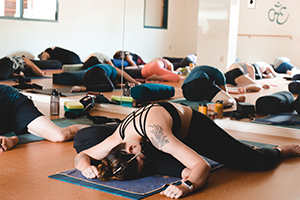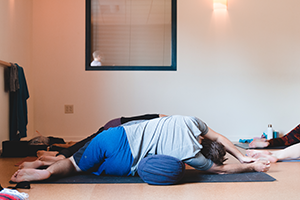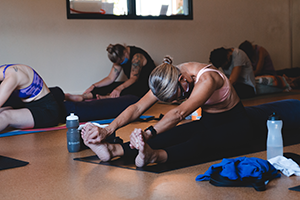Yoga For Better Sleep
by Nora Hill
Your alarm sounds. You blink your eyes open and wiggle your toes between your sheets, feeling energized and enthused for the day ahead. You find a luxurious full body stretch before your morning to-do list parades into your awareness. Suddenly you recall falling asleep easily and sleeping straight through the night. A smile that could rival the Cheshire Cat’s grin stretches across your face. You feel like you are ten years old again, a mid-February snow day has just been announced and countless adventures await.
Why Sleep is Important
An adequate amount of sleep is essential for true physical and mental health. Inadequate sleep is a massive health issue with around 30% of adults in the United States sleeping six or fewer hours each day. Chronic sleep deprivation has been linked not only to blunted cognition and mood, but cardiovascular disease, weight gain, overall increased mortality, and decreased quality of life.
How Yoga Impacts Your Sleep Patterns
Not surprisingly, the medical community is beginning to recognize the benefits of yoga in relation to sleep as well. A randomized trial comparing a regular yoga practice with an improved sleep hygiene control group found that the participants who practiced yoga reported greater improved sleep quality than the control group. In two other meta-analyses found exercise (i.e. walking) and meditation also improved sleep quality.
Regular exercise can decrease the time it takes to fall asleep, number of nighttime wakings, and daytime fatigue. Thus a commitment to three or more rigorous flow or hot classes fits this recommendation nicely, as does a brisk daily walk or jog or your preferred gym/weights routine. I’m sure many of you can attest to the fact that you tend have a better night’s rest overall when you’ve been active during the day. But not only do the aerobic effects of yoga come into play here, but the muscle stretching and lengthening effects of these yang yoga poses can alleviate any temporary muscle aches which can affect our sleep.
Bring the tempo down a bit in a slow flow class allows our minds to slow with our breath and postures, though the slow classes can truly be as challenging as vinyasa classes with their longer holds. And while a vinyasa practice can certainly be a moving meditation, these is no more lovely way to shift from the fight and flight mode of your day to the rest and digest mode of your night then with a yin practice where mindful awareness and release can truly be cultivated. But for me, the ultimate surrender before sleep is a yoga nidra practice.
Yoga Nidra
Yoga nidra, or yogic sleep, is a specific type of guided meditative journey that leads a person into a state of conscious sleep by relaxing the mind through the body. Yoga nidra provides a systematic approach to withdraw our awareness as we disengage our mind from sensory perception.
One question that came up for me was the difference between meditation and yoga nidra. At first blush, they seemed quite similar on the surface, but I felt there was a vast difference I simply couldn’t identify. After some reading, it made more sense.
Imagine yourself positioned comfortably in your favorite quiet place. Your mind is at ease and your body is relaxed. You feel quite calm but are still very aware of your environment. Now imagine yourself in a sound sleep. When sleeping, you have no awareness of your surroundings and are completely separated from your conscious mind. Yoga nidra can be thought as the subconscious bridge between the conscious and unconscious minds where sleep involves our unconscious mind. In yoga nidra, we maintain a thread of consciousness as we surrender into the most relaxed possible state in order to recharge and rejuvenate.
The goal of meditation, on the other hand, is about cultivating awareness and spiritual transformation. Meditation is an active practice of training the mind to one-pointed focus (i.e. a mantra, object, breath, etc.) With this intention, the mind is asked to focus on the object of meditation and gently asked to return when it loses focus and wanders.
While meditation asks for total concentration from its practitioner, yoga nidra is more passive or yin in nature as it encourages the mind to let go and naturally relax. In yoga nidra, I liken the ‘teacher’ to a friendly travel guide, the practice itself as a winding road, and the ‘student’ to a wanderlust-filled adventurer. Fun, right?!
With the numerous hats we wear and rigorous schedules we juggle, a solid seven to eight hours (at least,) may be more like a daydream than a reality for many. With a just two-year old and an almost three-month old at home, I fully admit a reasonable night’s sleep seems like a complete luxury. But even before kids, I struggled to sleep well. However, over the years, really since beginning my yoga practice, I have learned a few tricks that have helped me to get to sleep initially, to fall back asleep in the small hours of the morning, and to manage on sleepless nights. And yes, all circle back to yoga.
Bedtime Yoga Sequence
This video includes a bedtime yoga sequence to practice at home. If you don’t have the time to watch the whole thing, the poses are listed below. I used the playlist Jazz for Sleep on Spotify, but feel free to use any playlist that makes you feel grounded and calm.
Stand in Mountain at the top of your mat.
3-5 deep breaths.
2-3 half Sun Salutations (forward fold, halfway lift, forward fold, mountain).
Standing Backbend from Mountain pose, 2-3 breaths.
Forward Fold, 7-10 breaths. (Optional: bring your heels and hips against the wall for support)
Easy twist in Forward Fold, then return to a neutral Forward Fold, 2-3 breaths each side.
Interlace hands behind the head in your Forward Fold for 3-5 breaths, then release.
Return to Mountain post, then take 2-3 easy Sun Salutations: Extended Mountain, Forward Fold, Halfway Lift, Forward Fold, Tabletop, Cat/Cow, easy Backbend (Cobra, 8-Limbed, Soft Upward Facing Dog, Sphinx, etc…), Downward Facing Dog.
Childspose, 3-5 breaths.
Come to Tabletop, then Thread the Needle, 3-5 breaths each side.
Cat/Cow, 2-3 rounds.
Downward Facing Dog, 2-3 breaths.
Lift right leg, 3-Legged Dog, then step up to Low Lunge for 2-3 breaths.
Half Splits, 2-3 breaths.
Low Lunge with Easy Twist, 3-5 breaths.
Return to Downward Facing Dog, 2-3 breaths.
Repeat steps 13-16 on the left side.
Come to an easy seated position.
Neck stretches, 3-5 breaths each side: one hand grounds behind your seat, other hand reaches over the head and gently pulls the head towards the shoulder. Optional: bind the back hand behind the lower back.
Interlace hands behind the back, then forward fold over your lap, 2-3 breaths.
Seated spinal twist, 2-3 breaths each side.
Savasana / Yoga Nidra: 5-15 minutes.
Upcoming Pop-up Class at Inner Fire Yoga
I would love to share tips and perspectives on all things sleep with you during my upcoming pop-up Yoga for Better Sleep class on March 25th at noon at the West studio. During our hour together, I will lead yogis through a slow flow sequence before easing into a restorative/Yin sequence designed to be practiced before bed. Aromatherapy, hands-on assists and a sum-up Q&A session will be offered, as well as a link to a recorded session for at home use.
Hope to see you there :)
-Nora
References:




